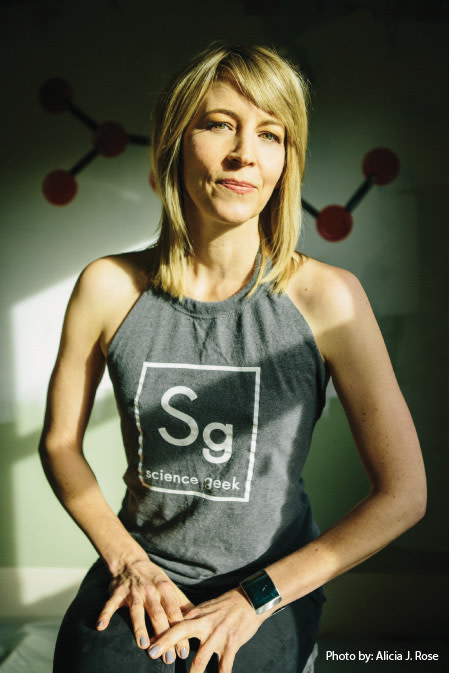6 Things We Learned from Christine McKinley's Physics for Rock Stars

Image: Alicia J. Rose
If you found yourself struggling through high school physics class unable to digest atomic weights or electromagnetic forces, writer Christine McKinley has skimmed the surface of what makes physics cool and wrapped it into an easy-to-comprehend Physics for Rock Stars.
Of course, if anyone can make science cool, it’s McKinley. She’s a mechanical engineer, musician, author, and television host for the History Channel’s Brad Meltzer’s Decoded and previously for the Discovery Channel’s Under New York. Physics for Rock Stars combines all these fields—along with examples using drinking, heists, and being a ninja or a rock star—as it bounds through the laws of physics, masquerading as one part memoir, one part self-help manual, and one part pop science.
McKinley first tried to put the laws of the universe and the scientific method to work for her in an attempt to be cool in middle school. It led to the conclusion that cool kids 1) smoke and 2) ditch class. The experiment failed and her parents put her in Catholic school, but that didn't stop her. She goes on to apply the laws to dating, goal setting, and life planning.
Here are six of the many things we learned:
Christene McKinley Book Release Party with Sangria, Sweets, and Science Songs
Christopher David Design
901 NW 10th Ave
June 15
Also, McKinley is part of the new band Swan Sovereign, which plays an intimate show in the middle of the Crystal Ballroom Thursday, June 12.
- Should you ever find yourself backstage with two arrogant lead singers raving about their ability to rock the mic, you can swindle them out of some money and pride with a very long straw and a bet about lung capacity, while also proving a little something about atmospheric pressure .
- If anyone in Finland ever challenges you to a drinking contest (and they likely will), but you suspect they’re already off to a head start and can’t see through their thick black Finnish beer bottles, simply blow into your bottle, then theirs, and if theirs has a lower sound, call the whole thing off because you know that sound travels in waves and is bouncing off a beer level that is lower than yours (also useful for figuring out which beer is yours on a crowded table).
- Trying to decide whether to start your own company? Do like the aerospace industry does and draw your own “free body diagram.” Like an airplane, you need parts working in synchronicity, providing a balance of thrust and drag, weight and lift. You have optimism? You’ve got lift. You have some doubt telling you not to quit your day job? Drag. You have that hefty resume and ambition? Thrust. You’ve got a nest egg to pay bills and get that office space? Weight. That's easy, right?
- Fighting on top of a moving train? As it veers right, kick with your left leg and send Evil Baddy flying off because you’re all too aware of Newton’s first law, which states that a body in motion stays in motion. That guy will keep going until he hits something else and transfers all of his energy to that thing. Other laws will determine if he goes splat (i.e. brick wall) or does a nice barrel roll (i.e. field of fluffy mattresses).
- When you’re on a walkabout in Australia and find your water’s mucked up, you can pull out two bowls—one big, one small—cover the large on in plastic and wait as condensation happens, separating the muck from the clean water.
- You have more in common with the periodic table than you thought. The way atoms swirl around with their varied number of electrons looking to covalently bond with, or in some cases, ionically bond with other elements is like watching the Atomic Dating Game. If you can identify your dating profile, you too can unlock the secrets of attraction. Are you the Pollyanna type with your one electron (Sodium) that always seems to attract the boy from the wrong side of the tracks (Chlorine)? It makes sense. Clearly you’re both trying to fill your outer electron shell, which states that you must have eight. He hogs her electron, turning her on, while he turns into a drunken lout after only a couple dates, but the attraction is so strong neither can leave. Perhaps you’re a noble gas? You are whole as you are and don’t react well with others, but you also don’t get asked out a lot.
Physics gets a little formulaic at times in terms of structure, not to mention outlandish in its examples, but then, so do most textbooks. At least in this book, McKinley keeps a fairly clipped pace by just touching on the essentials of physics without drowning you in gnarly sulfur-smelling water from some experiment gone wrong, arming you with enough facts to impress friends at nerdy cocktail parties.
Indeed, if you want to be that person that makes others feel real small and slack-jawed, she even gives you lengthy numbers and equations you can write down and stuff up your sleeve for just such an occasion.




